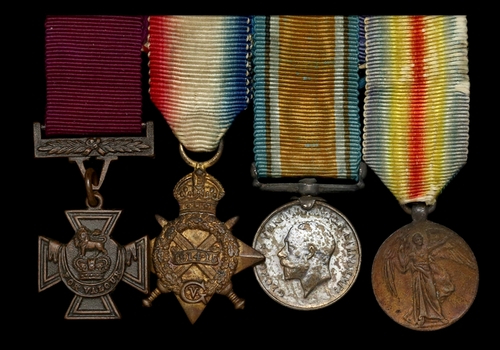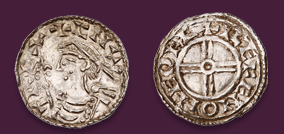
Auction: 25003 - Orders, Decorations and Medals
Lot: 324
The 'Attack on Ledeghem 1918' mounted V.C. group of four dress miniatures attributed to Lieutenant R. V. Gorle, Royal Field Artillery
Victoria Cross; 1914-15 Star; British War and Victory Medals, mounted as worn, good very fine (4)
V.C. London Gazette 13 December 1918:
'For most conspicuous bravery, initiative and devotion to duty during the attack on Ledeghem on 1st October, 1918, when in command of an 18-pdr. gun working in close conjunction with infantry. He brought his gun into action in the most exposed positions on four separate occasions, and disposed of enemy machine guns by firing over open sights under direct machine-gun fire at 500 to 600 yards' range. Later, seeing that the infantry were being driven back by intense hostile fire, he, without hesitation, galloped his gun in front of the leading infantry, and on two occasions knocked out enemy machine guns which were causing the trouble. His disregard of personal safety and dash were a magnificent example to the wavering line, which rallied and re-took the northern end of the village.'
Robert Vaughan Gorle was born at Southsea, Hampshire on 6 May 1896, the son of Ethel and Major Harry Gorle, D.S.O. His father served during the Anglo-Boer War where he was to earn his D.S.O. The young Gorle was educated at Wells House School, Great Malvern, the school where Sir Edward Elgar worked as a music master. He ended Dickinson's House, Rugby School- now Bradley House- but remained there only a year before his family emigrated to Transvaal.
Completing his education in South Africa he lived upon his family farm but returned to Britain upon the outbreak of the Great War. Commissioned 2nd Lieutenant on 15 May 1915 with the Royal Field Artillery his battery served attached to the 50th Brigade, 31st Division.
The Victoria Cross on the Western Front, outlines his early service, stating:
'Robert applied for a commission on 19th April 1915 and was commissioned on 15th May into 161st Brigade, Royal Field Artillery, 31st Division. He was described as 6' 1½" tall and weighed 156 lbs. Before 31st Division embarked for Egypt, all the artillery units left it on 2nd December and assembled at Larkhill, Wiltshire. Between 30th December 1915 and 3rd January 1916 they moved to France to join 32nd Division. Robert sailed for France on 31st December 1915. He was wounded by a gunshot in the left arm on 3rd July 1916 and was evacuated to England the next day on HMHS Egypt from Le Havre to Southampton, arriving on 5th July. He was treated at 1st London General Hospital, Camberwell from 6th July. A medical board there on 31st July found him unfit for any service for two months and he was granted leave until 30th September at The Grove, Passage West, Co Cork. He then transferred to Assistant Director Medical Services, Cork District, Irish Command. A medical board at the Central Military Hospital, Cork on 9th October found him unfit for General Service for one month but fit for Home Service. On 23rd October he joined 23rd Artillery, 5th B Reserve Brigade at Ballincollig, Ireland. A medical board at the Central Military Hospital, Cork on 9th November found him fit for General Service. He was promoted lieutenant on 1st July 1917.'
Returning to France he was posted to command 'A' Battery, 50th Brigade, Royal Field Artillery, going into action in the Fourth Battle of Ypres and pushing steadily forward. The unit reached Ledeghem, west of Courtrai, supporting the 9th Division in their advance, it was here that Gorle was to win his V.C. The Final Advance, September to November 1918 expands upon the citation, stating:
'9th Division, 29 September to 2 October, Broodseinde Ridge
to Ledeghem
The Newfoundland Battalion and the 9th Scottish Rifles 'suffered grievously' as they battled through the Flanders Position I on 29 September. The 5th Camerons reinforced the left flank, where the Belgians were struggling, while the 11th Royal Scots and 6th KOSBs tackled Terhand on the right. The Germans withdrew as soon as Lieutenant Colonels Campbell and Smyth had forced a way through.
Major General Tudor had to wait for the divisions on his flanks to catch up before attacking the Flanders II Line on 1 October. The 8th Black Watch and 7th Seaforths cleared the pillboxes around St Pieter while the 12th Royal Scots and 6th KOSBs fought their way into Ledeghem; they had to withdraw because their flanks were exposed. Field guns worked in close cooperation with the infantry and Lieutenant Robert Gorle's crew manhandled their weapon forward to support an unsuccessful attack on Hill 41. He then rallied the infantry to make a second attempt. Gorle would be awarded the Victoria Cross.'
Invested with his award at Buckingham Palace on 14 June 1919 he relinquished his commission on 25 July 1919. Gorle returned to Africa where he settled near Fort Jameson, Rhodesia as a farmer, there he was appointed Sergeant-At-Arms and Librarian of the Rhodesian Parliament between 1929-37. Marrying Ruth Thomas in 1924 he had three children, Gorle died at Durban on 11 January 1937, he is further commemorated upon the Royal Artillery Memorial, Woolwich' sold together with copied research.
Subject to 20% VAT on Buyer’s Premium. For more information please view Terms and Conditions for Buyers.
Estimate
£600 to £800
Starting price
£480




